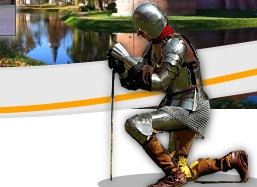| The castle in Prussian Eylau (Bagrationovsk)
The castle was established in 1325-1326. A flat hill with
marshes and water reservoirs to its three sides was chosen
as a suitable location for the fortress. The east wing most
probably contained a gatehouse, the south wing housed the
castle chapel while the north wing was connected to a sanitary
tower. The whole of the first floor was occupied by the refectory,
chapter room, bedrooms and chambers for the Teutonic official
called der Pfleger. The second floor served a defensive function.
The remaining rooms were used for household purposes.
During the times of the Teutonic state the castle as a seat
of der Pfleger was an administrative centre for the nearby
district and a fortified stronghold, which defended the southern
access to the state capital, Königsberg. Today we are familiar
with the names of twenty Teutonic castle administrators, including
Konrad Wallenrod, the future Grand Master of the Teutonic
Order in 1391-1393.
In 1336 the castle and the settlement outside its walls were
named Prussian Eylau. In 1429 the castle was granted to Heinrich
von Plaun in reward for his war services. Von Plaun's coat
of arms later became part of the town's emblem. In the years
to follow the castle often passed hands. After the dissolution
of the Teutonic Order, the castle became a seat of the local
administrative district. When the Kingdom of Prussia was formed,
the castle housed the administration officials managing the
royal domain. In the 18th century the castle became a private
property, called Henriettenhof. In the early 19th century
the building was badly damaged by a fire, after which it was
not reconstructed and slowly fell into ruin.
Until the present day, the remaining parts of the castle include
the foundations of the great hall and a complete Gothic granary.
Today there are plans to prepare the whole castle compound
to serve tourist functions.
Museum of the History of the Bagrationovsk
Region
The Bagrationovsk administrative district contains
sites associated with Napoleon Bonaparte's campaigns, well
known in European history. On the 7th and 8th of February
1807 the French army, commanded by Napoleon, took part in
a great battle at Prussian Eylau against the Russian army
under Marshal Levin Benningsen, supported by Prussian troops
led by general Anton L'Estocq.
The monument raised on the 50th anniversary of the battle
has survived until today and is situated about 1 km south-east
of the town of Bagrationovsk, towards the Russian-Polish border.
It is a high obelisk made of sandstone, in the shape of a
neo-Gothic spire, embellished with medallions showing faces
of the commanders of the forces allied against the French
Emperor: Benningsen, L'Estocq and Christoph Friedrich von
Diericke, the commander of the 1st Division in the Prussian
corps.. On each side of the monument there are canons dating
back to the mid-19th century. The design of the monument was
drawn at the workshop of Fredrich Stüler, according to the
idea suggested by the Prussian king, Frederic Wilhelm IV.
In 1999, owing to the initiative of the Museum of the History
of Bagrationovsk and the Napoleon Centre in Paris, a commemorative
plaque was placed on the wall of the house at 19 Central Street,
which is a remaining part of the building which housed Napoleon's
headquarters from 7th to 17th February 1807. This house has
been commonly known as Napoleon's house for years.
The Battle at Prussian Eylau is also remembered at the Museum
in Bagrationovsk, which holds a large exhibition on this historical
event, including a scale model of the battlefield, where the
position of both armies is represented using lead model soldiers.
Other mementos of the battle owned by the museum comprise
Prussian and Russian coins, small iron crosses, money pouches,
uniform buttons found during archaeological excavations at
the battlefield. The Museum is also the main organiser of
the annual battle enactment, which has been held for several
years now, with the participation of groups from Russia, Poland,
Lithuania and Belarus.
Apart from this, the Museum also shows exhibits related to
the history and culture of Prussians (the Natangians) and
the most contemporary days of Bagrationovsk.
The Museum also holds temporary exhibitions, museum lessons
for children and teenagers as well as tours of the town and
local area following historical monuments.
Museum of the History of the Bagrationovsk
Region
10 Kaliningrad Street, Bagrationovsk, Russian Federation
tel. 00 74015632084, e-mail: bagrmus@rambler.ru
|






![]()
![]() The
project is co-financed from the funds of the European Regional Development Fund,
under the framework of the Lithuania,
The
project is co-financed from the funds of the European Regional Development Fund,
under the framework of the Lithuania,